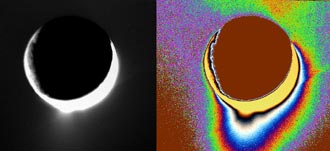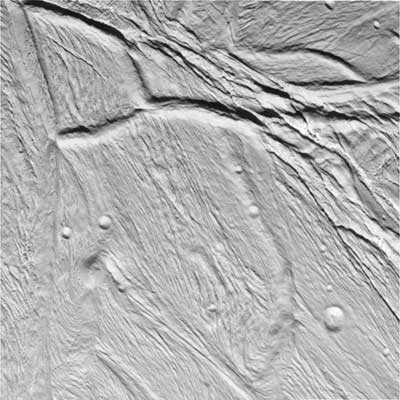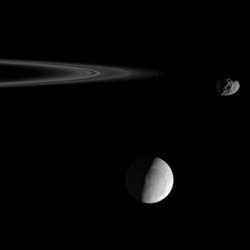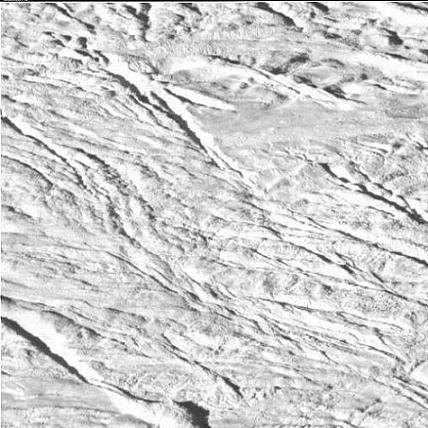The American spacecraft "Cassini" discovered signs indicating the presence of water on Saturn's moon Enceladus. NASA reports that the water was discovered in geysers, and that it springs from the surface
11.3.2006
By: Avi Blizovsky

The left photo is the original photo taken in February 2005 but was only published this week. In the right picture - rendering in artificial colors illustrating the thin atmosphere and the water erupting from Enceladus. Photo: NASA
Saturn's moon Enceladus likely contains a liquid ocean beneath the ice layer. This is according to data transmitted by the Cassini spacecraft orbiting Saturn. Until the beginning of Cassini's operation, the tiny moon did not arouse much interest, but now it is the focus of extensive research following the discovery that it is geologically active.
Enceladus likely contains reservoirs of liquid water just below the surface that erupt in geysers - and where there is water, there may also be life, the scientists say. These jets were observed from "hot spots" in the south pole area of the moon.
Mission scientists compared them to geysers in Yellowstone National Park in the US.
"We immediately understood that this was a radical conclusion - that there may be evidence of the existence of liquid water in such a short and cold body." said Dr. Carolyn Furco, director of the Cassini Imaging Team and the Space Science Institute in Boulder, Colorado. "However", she added, "if we are right, then it is about expanding the variety of solar system environments where the conditions suitable for living beings can potentially be created." There is nothing more exciting than that."
Dr. Jeffrey Cargel of the US Geological Survey believes that shifting ice sheets and tidal waves can create and trap heat that will help create the activity we see on Enceladus. According to the model he developed, a deep ocean of water saturated with gases like carbon dioxide is trapped under the ice. This gas is trapped in the ice layer and may have also sunk to the bottom of the sea, which is also made of ice."
Other researchers say that the plume observed at the South Pole may have been caused by the eruption of a pocket of water at a small depth, at a temperature above zero degrees Celsius, a kind of cold version of the ancient permanent geyser erupting in Yellowstone.
A closer look at Enceladus21.2.2005

https://www.hayadan.org.il/enceladus210205.html
Just two days after the last flyby of Titan, Cassini passed another Saturnian moon: Enceladus. The spacecraft approached a distance of 1,180 km from the bright moon.
Enceladus is an unusual moon due to the high light reflectance of its surface, reminiscent of freshly fallen snow. But the closest look, close-up, the best shot so far, he looks much more wrinkled. Enceladus is only 505 kilometers in diameter.
This image was taken on February 17, 2005 in visible light using Cassini's narrow-angle camera from a distance of 10,750 km. The separation is 60 meters per pixel.
Enceladus and Janus in one Cassini frame
Janus (which is 181 kilometers in diameter), is best known for its interchange of orbits with the moon Epimetheus.
1.7.2006
By: Avi Blizovsky

This image was taken in visible light by Cassini's narrow-angle camera on May 21, 2006, from a distance of about 565 km from Mars, 702 km from Enceladus, and about 530 km from Saturn. The scale of the image is 3 km per pixel on Janus and 4 km per pixel on Enceladus.
For the news in Universe Today
Close-up of Enceladus
24.7.2005
The Cassini spacecraft has completed the best approach flyby yet to Enceladus. The event took place on July 14, 2005. The image was taken using the wide-angle camera from a distance of about 210 kilometers above the icy surface of the moon.

